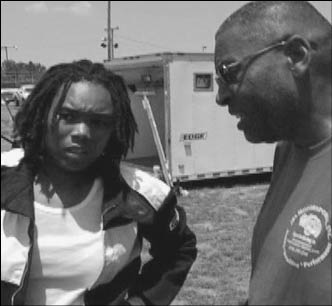Next story: Jonestown: The Life and Death of Peoples Temple
Playing Hard is Hard Work: Cinnamon
by Girish Shambu

The comedian Albert Brooks once cracked that if an alien were to learn about life on Earth by watching our movies, he’d be convinced that the planet was swarming with cops. The world depicted in most of the movies we watch is an alternate reality, often bearing little resemblance to our world or our lives.
Case in point: There are so few movies that show us, with respect and attention, the world of work. Considering that we spend a huge portion of our waking lives working, you’d think it would be a pretty important subject for portrayal in the movies. But it’s not so. Surely it isn’t due to a belief that work is inherently uninteresting, because what would that say about the way we choose to spend a large chunk of our lives?
Kevin Jerome Everson’s experimental film Cinnamon is set in the world of African-American drag racing. It depicts the routines and rituals—the hard work—of a young driver who is a bank teller by day (Erin) and her mechanic (John) as they get ready for a race. We don’t see the race, just the hundreds of small acts of preparation that it takes to get there. Working and adjusting the cars bit by bit, training the driver to constantly improve reaction time, getting into the pre-race headspace: These actions are not filmed with quick cuts and fast camera moves as if they were brief pit stops before getting back on the racetrack of the story—they are the story.
What makes Cinnamon an “experimental” film is the way it bypasses most of the ingrained conventions of movie storytelling. Rather than whip up a speedy narrative with efficient exposition, well-rounded characters, a central conflict and a dramatic arc, this movie proceeds by an alternate route: trying to capture sensations and moments, action and gesture, the texture of sound and the quality of light, as a way of demonstrating to us that they are every bit as worthy of our attention as narrative momentum or character development.
Another experimental aspect of the film is the way it blurs fiction and documentary. John is a real-life mechanic and a drag-racing legend in Virginia, but the driver is played by an actress. (I must confess sheepishly here that the first time around I was utterly convinced that I was watching a pure documentary.) Staged and scripted bits are mixed in with documentary interview scenes. But the result is, oddly, a seamless whole that feels naturalistic and true.
Ultimately, one of the key differences between experimental film and non-experimental mainstream/indie cinema is that between poetry and prose. When it comes down to it, movies are made of two things: 1) pictures, and 2) sounds. Cinnamon treats these two basic elements as if they were the building blocks of poetry, with a life of their own, rather than being slave to the prose of a propulsive narrative.
For example, shots of cars in firm focus are laid against soft-focus images of a Southern garden. Moments of action, like cars in high-speed motion, are intercut with moments of rest and reflection. The metallic hum of a car engine sets a mood and accompanies the images as if it were taking the place of dialogue or narration. So, as in poetry, the focus of the work becomes: the beauty, rhythm and texture of images and sounds. Which can sometimes bring experimental movies closer—make them truer—to the way we perceive and experience the world from day to day and moment to moment.
|
Issue Navigation> Issue Index > v5n48: Gray Anatomy (11/30/06) > Film Reviews > Playing Hard is Hard Work: Cinnamon This Week's Issue • Artvoice Daily • Artvoice TV • Events Calendar • Classifieds |









 Current Issue
Current Issue